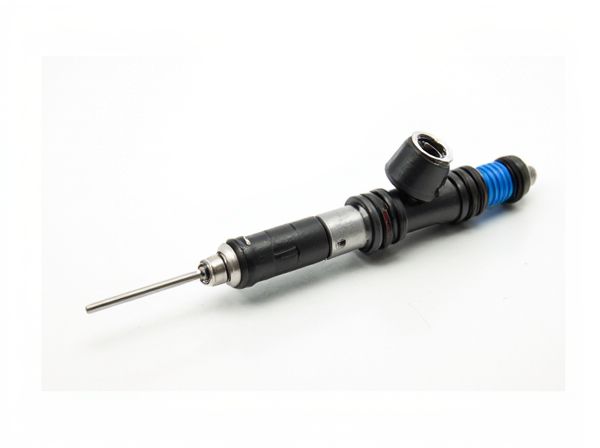
Photo illustration: Short injector vs Long injector
Short injectors typically deliver fuel more rapidly and are suited for applications requiring quick response times, while long injectors provide a more prolonged fuel spray, enhancing atomization and combustion efficiency in larger engines. Your choice between short and long injectors depends on factors such as engine displacement, fuel type, and desired performance characteristics. Optimizing injector length can significantly impact fuel efficiency and engine power output.
Table of Comparison
| Feature | Short Fuel Injector | Long Fuel Injector |
|---|---|---|
| Design | Compact, shorter nozzle | Extended nozzle length |
| Spray Pattern | Wider angle, shorter reach | Narrower angle, deeper penetration |
| Fuel Atomization | Good for low to mid RPM | Better for high RPM and performance |
| Installation | Easier, fits tighter engine bays | Requires more space, complex fitment |
| Application | Daily use, fuel efficiency focused | High-performance, racing engines |
| Cost | Generally lower | Higher due to design complexity |
Introduction to Fuel Injectors
Fuel injectors are critical components in modern internal combustion engines, responsible for delivering precise amounts of fuel into the combustion chamber. Short injectors typically offer faster response times and are designed for high-performance or smaller engines where space constraints exist. Long injectors provide greater fuel volume capacity, making them suitable for larger engines or applications requiring higher fuel flow rates to maintain optimal combustion efficiency.
What is a Short Injector?
A short injector is a type of fuel injector characterized by its compact design, typically shorter in length compared to long injectors, enabling easier integration into tight engine spaces. It delivers precise fuel atomization and spray patterns optimized for efficient combustion in modern gasoline or diesel engines. Short injectors are commonly used in high-performance and turbocharged engines due to their fast response times and accurate fuel delivery.
What is a Long Injector?
A long injector refers to a fuel injector designed with an extended length to accommodate engines with deeper intake ports or unique fuel delivery systems. It ensures precise fuel atomization and optimal spray patterns for efficient combustion in high-performance or modified engines. Long injectors often provide increased fuel flow rates compared to short injectors, enhancing engine power and responsiveness.
Key Differences Between Short and Long Injectors
Short injectors typically have a length under 80mm, designed for compact engine bays and easier installation, while long injectors exceed 80mm, suitable for engines requiring deeper fuel delivery. Short injectors often provide quicker response times due to reduced fuel travel distance, enhancing throttle precision, whereas long injectors allow for higher fuel volumes, supporting high-performance or heavily modified engines. The key differences lie in physical size, fuel delivery capacity, and application suitability, impacting engine tuning and efficiency.
Performance Impacts: Short vs Long Injectors
Short injectors provide quicker fuel delivery due to their reduced needle travel, improving throttle response and potentially enhancing engine efficiency at higher RPMs. Long injectors, with extended needle travel, allow more precise fuel metering and smoother atomization, which benefits low-end torque and reduces emissions. Optimal injector length selection depends on engine design and desired performance characteristics, balancing responsiveness against fuel atomization quality.
Fuel Efficiency Considerations
Short injectors deliver fuel in quick bursts, allowing for precise fuel metering that can improve fuel efficiency at lower engine loads. Long injectors provide a longer injection time, which may be beneficial for high-performance engines but can lead to increased fuel consumption due to less precise atomization. Choosing between short and long injectors depends on the engine's operating conditions and the desired balance between power output and fuel economy.
Installation and Compatibility
Short injectors typically offer easier installation in compact engine bays due to their smaller size, allowing for straightforward fitment without significant modifications. Long injectors require more space and may need additional clearance or adaptors, making them better suited for engines designed with longer fuel rails. Compatibility depends on vehicle-specific injector port size and fuel system pressure requirements, with precise matching essential to ensure optimal performance and avoid leakage or improper spray patterns.
Cost Comparison
Short injectors typically cost less upfront due to simpler design and lower material usage, making them a budget-friendly option for basic fuel injection systems. Long injectors, while more expensive initially, offer enhanced fuel atomization and efficiency, potentially lowering long-term maintenance and fuel costs. Evaluating total cost of ownership, including durability and performance benefits, is essential when choosing between short and long injectors.
Applications and Best Use Cases
Short injectors are ideal for compact engine designs and applications requiring quick fuel delivery, such as sport motorcycles and small displacement vehicles, due to their faster response time and precise fuel atomization. Long injectors perform best in high-performance or heavy-duty engines, like trucks and performance cars, where deeper fuel penetration and better mixing are critical for efficient combustion and power output. Selecting between short and long injectors depends on engine size, fuel requirements, and specific performance goals to optimize fuel efficiency and emissions.
Choosing the Right Injector for Your Needs
Choosing the right injector depends on your specific application and engine requirements, as short injectors typically offer faster fuel delivery, enhancing throttle response and performance in high-revving engines. Long injectors provide greater fuel capacity, making them ideal for engines needing higher fuel flow rates or extended spray duration for better combustion efficiency. Carefully match injector size with fuel requirements, engine displacement, and power goals to optimize performance and avoid issues like poor fuel economy or engine knocking.
 caratoz.com
caratoz.com